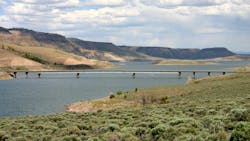Colorado DOT Makes Progress on Repairing Closed U.S. 50 Bridge
Repairs to Colorado’s U.S. 50 bridge over the Blue Mesa reservoir could take anywhere from four weeks to several months after Colorado Department of Transportation (CDOT) crews finish inspecting for additional cracks, state transportation leaders said Tuesday.
CDOT is considering four repair options, all of which depend on the extent of damage to Middle Bridge, a 1,500-foot-long bridge carrying U.S. 50 traffic over the lake, officials said recently at a community meeting.
The department shut down the bridge April 18 due to concerns for bridge safety after cracking was noticed. The bridge closure is located between Gunnison and Montrose from U.S. 50-mile marker 131, the intersection with Colorado Highway 92, to mile marker 138. It is located east of the U.S. 50 Little Blue Creek Canyon project, which is currently in a planned winter shutdown.
Lt. Gov. Dianne Primavera declared a disaster emergency to help support the response and recovery with a coordinated framework for the statewide response to reopen the bridge. The declaration also initiated the process for requesting federal assistance which includes supplemental highway funding.
Crews are about 40% complete with its inspection, officials said, calling it a “slow process” that involves scraping off the paint, grinding down or sandblasting the area and conducting ultrasonic testing on each location. Inspectors did not find any “visual issues” with the shorter bridge 2 miles to the west, made of the same type of steel, but will conduct further inspection in the future.
The ultrasonic testing results are then sent to experts to review and look for “anomalies,” Smith said. So far, 40 locations have been scanned and 25 anomalies have been found, he said.
Officials said they hope to get enough repairs completed before end of October, when inclement weather would likely complicate or stop the work. The bridge is made of type T-1 steel, which is three times the strength of normal steel and makes repairs more challenging, Smith said.
The best repair option for the bridge will depend where and on how severe the anomalies are, Smith said.
The best-case scenario — and quickest option — for repairs involves attaching 12-foot plates in areas along the bridge where anomalies are found, said Jason Proskovec, a project manager with Kiewit Engineering Co., a company that has completed major infrastructure projects in Colorado, including the rebuilding of U.S. 34 in Big Thompson Canyon after the 2013 floods.
The worst-case scenario would be a complete replacement of the bridge’s three spans, which could require construction crews and engineers to work from man lifts and cranes in the water to make the repairs.
“I think right now it’s low probability, but it is still a possibility,” Proskovec said in a statement. Kiewit has already obtained the first 88 tons of steel needed for repairs.
Keith Stefanik, a CDOT engineer, said he did not have an exact date as to when a single lane of traffic may be allowed over the bridge.
“Our short-term goal is to make enough repairs to get this open to some type of interval traffic. We’re not sure on that perspective yet, but we will weigh all the options on how we can repair it with traffic intermittently closed or how we can repair it with traffic closed at all times of the night,” Stefanik said in a statement.
“We need to know exactly what’s failing, what’s good, where the defects are, so that we can shore up this bridge and make the proper design decisions,” he said. “We will hit the ground running and make sure that we try to reduce the closure period of this bridge to the shortest range possible.”
State officials have discussed temporary options to get travelers from one side of the reservoir to another in the meantime — from ferries to floating bridges — but said their attention is focused on repairing the bridge.
The bridge closure has complicated critical commutes along the vital route that connects Gunnison to Montrose. Some students took a 30-minute ferry ride across the choppy waters to get to school. Gunnison Valley Hospital shifted to disaster management mode to figure out how to deliver critical care to kidney and cancer patients.
“The group’s consensus has been that focusing our immediate efforts on doing everything we can to fortify local groups is the best bang for our buck in getting more people to and from,” said Shoshanna Lew CDOT Director, in a statement.
--------------------------------------------------------------------------
Source: Colorado Sun, CBS News
